2014 NISSAN XTERRA warning light
[x] Cancel search: warning lightPage 10 of 384
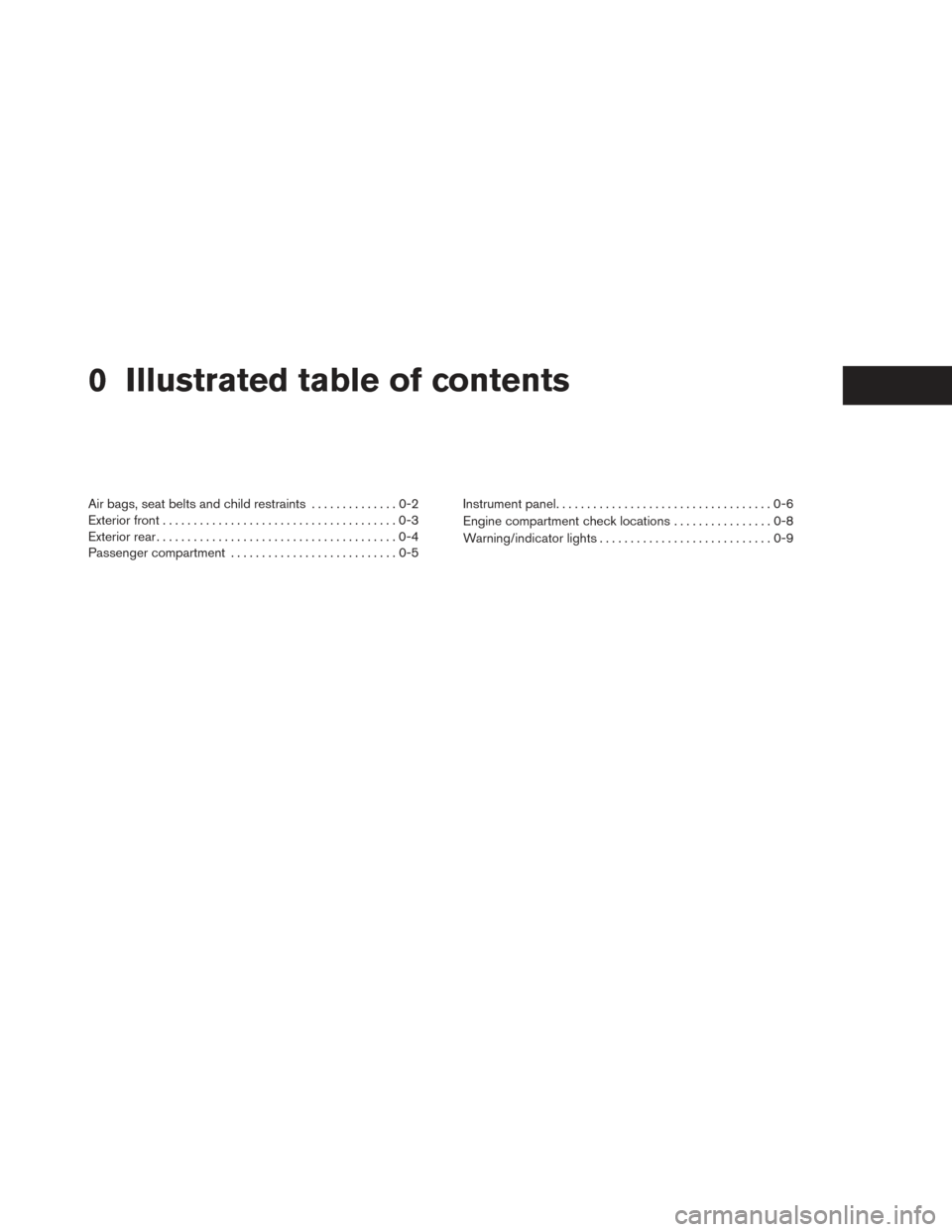
0 Illustrated table of contents
Air bags, seat belts and child restraints..............0-2
Exterior front ......................................0-3
Exterior rear .......................................0-4
Passenger compartment ...........................0-5 Instrument panel
...................................0-6
Engine compartment check locations ................0-8
Warning/indicator lights ............................0-9
Page 15 of 384
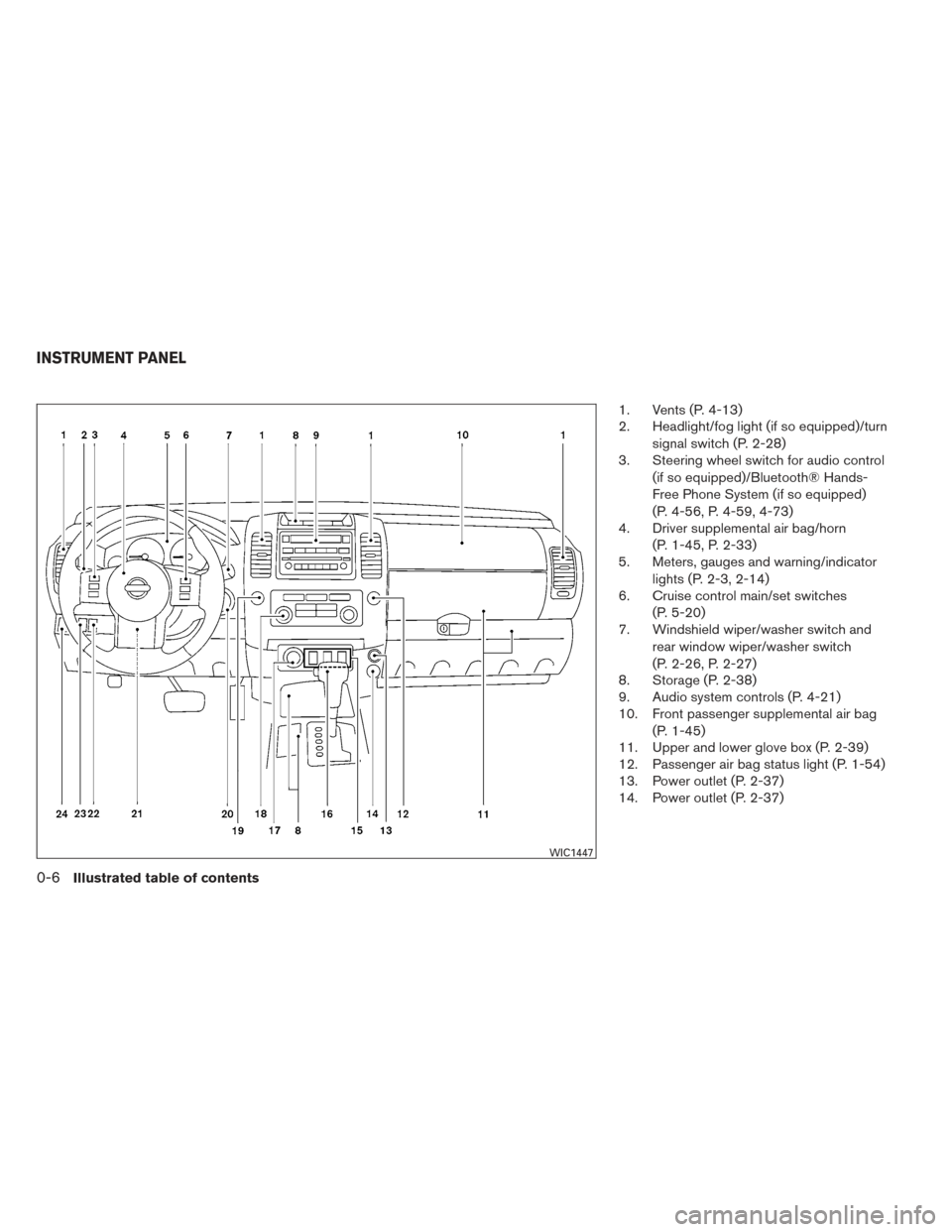
1. Vents (P. 4-13)
2. Headlight/fog light (if so equipped)/turnsignal switch (P. 2-28)
3. Steering wheel switch for audio control
(if so equipped)/Bluetooth® Hands-
Free Phone System (if so equipped)
(P. 4-56, P. 4-59, 4-73)
4. Driver supplemental air bag/horn
(P. 1-45, P. 2-33)
5. Meters, gauges and warning/indicator
lights (P. 2-3, 2-14)
6. Cruise control main/set switches
(P. 5-20)
7. Windshield wiper/washer switch and
rear window wiper/washer switch
(P. 2-26, P. 2-27)
8. Storage (P. 2-38)
9. Audio system controls (P. 4-21)
10. Front passenger supplemental air bag
(P. 1-45)
11. Upper and lower glove box (P. 2-39)
12. Passenger air bag status light (P. 1-54)
13. Power outlet (P. 2-37)
14. Power outlet (P. 2-37)
WIC1447
INSTRUMENT PANEL
0-6Illustrated table of contents
Page 18 of 384
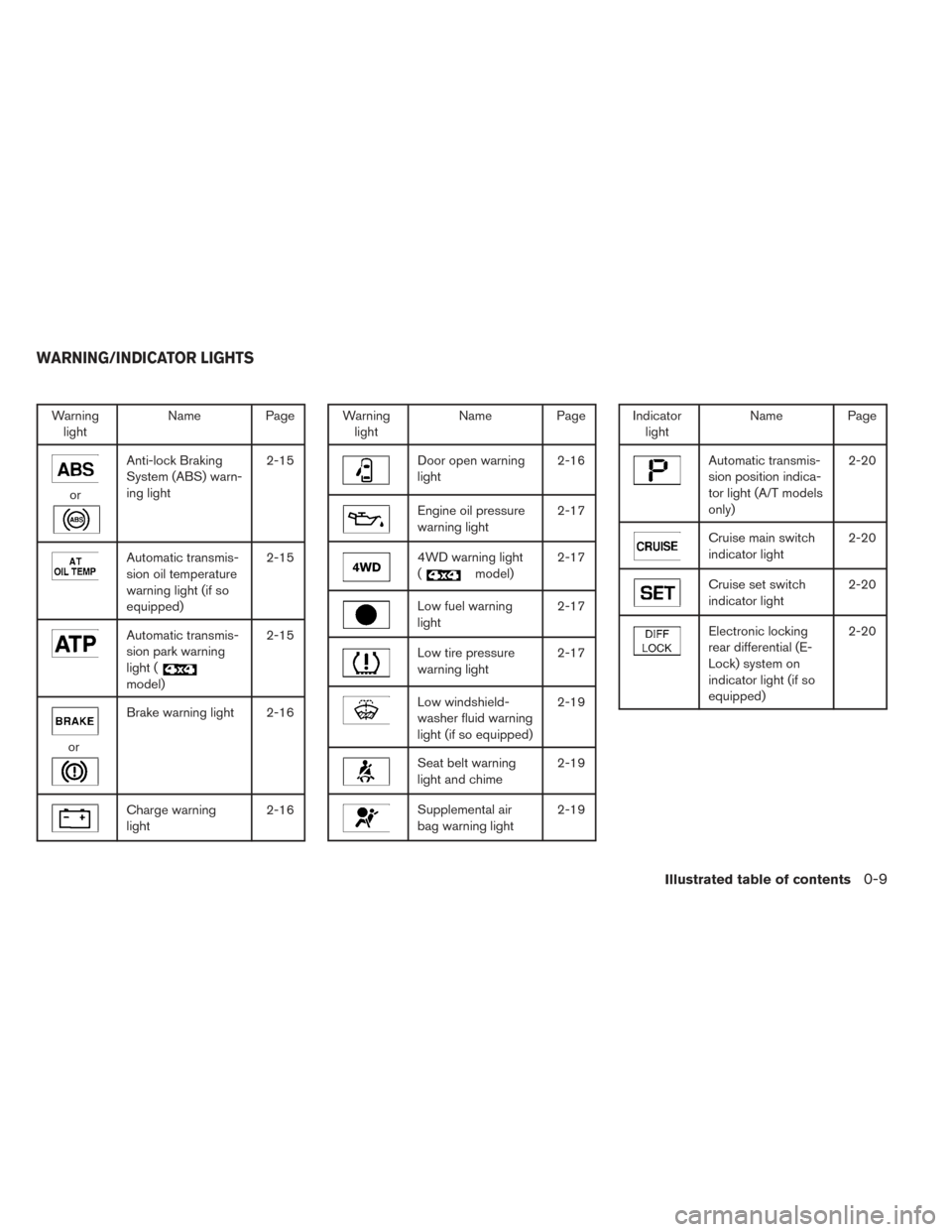
Warninglight Name Page
or
Anti-lock Braking
System (ABS) warn-
ing light 2-15
Automatic transmis-
sion oil temperature
warning light (if so
equipped)2-15
Automatic transmis-
sion park warning
light (
model)2-15
or
Brake warning light 2-16
Charge warning
light
2-16
Warning
light Name Page
Door open warning
light 2-16
Engine oil pressure
warning light2-17
4WD warning light
(
model)2-17
Low fuel warning
light 2-17
Low tire pressure
warning light2-17
Low windshield-
washer fluid warning
light (if so equipped)2-19
Seat belt warning
light and chime
2-19
Supplemental air
bag warning light2-19
Indicator
light Name Page
Automatic transmis-
sion position indica-
tor light (A/T models
only) 2-20
Cruise main switch
indicator light
2-20
Cruise set switch
indicator light2-20
Electronic locking
rear differential (E-
Lock) system on
indicator light (if so
equipped)2-20
WARNING/INDICATOR LIGHTS
Illustrated table of contents0-9
Page 20 of 384
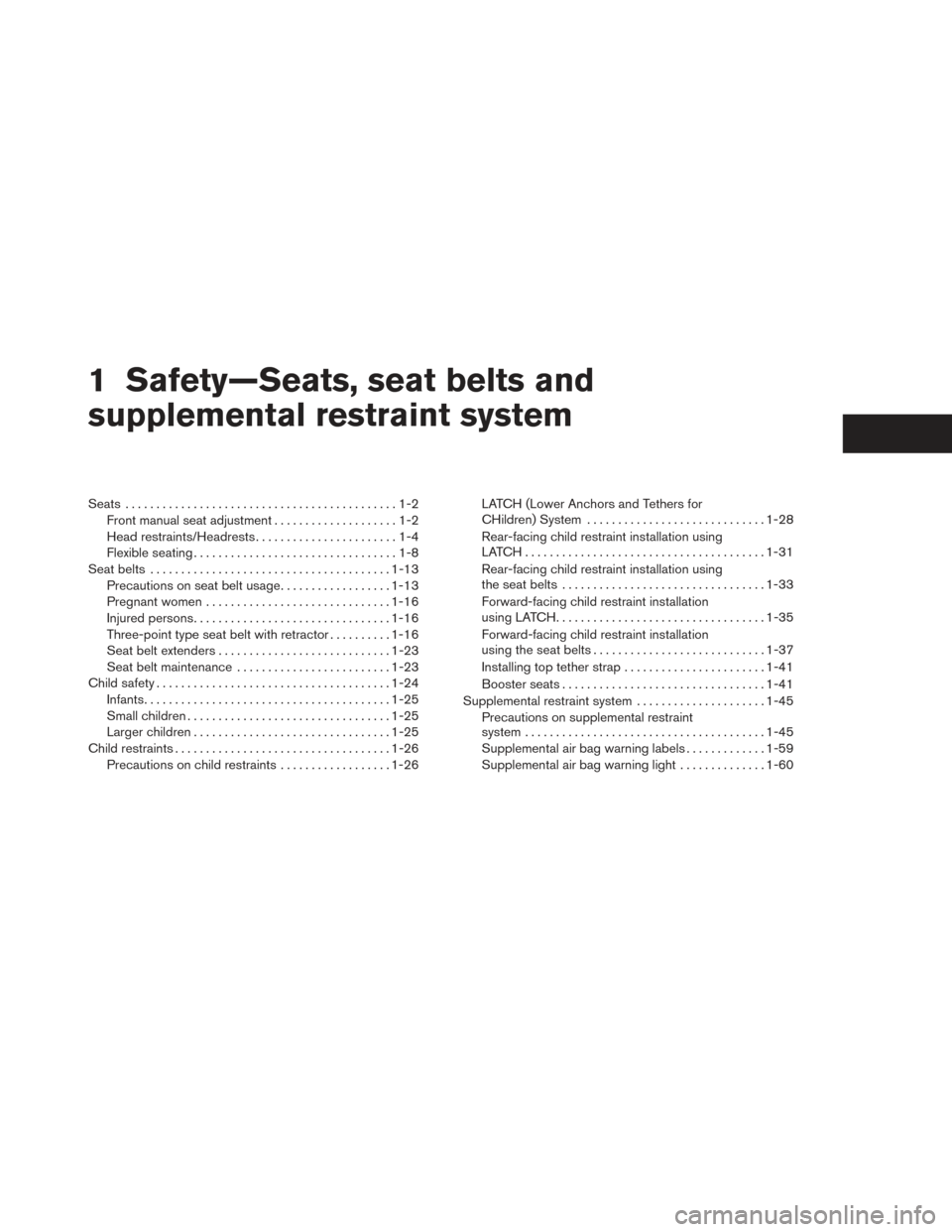
1 Safety—Seats, seat belts and
supplemental restraint system
Seats ............................................1-2
Front manual seat adjustment ....................1-2
Head restraints/Headrests .......................1-4
Flexible seating .................................1-8
Seat belts ....................................... 1-13
Precautions on seat belt usage ..................1-13
Pregnant women .............................. 1-16
Injured persons ................................ 1-16
Three-point type seat belt with retractor ..........1-16
Seat belt extenders ............................ 1-23
Seat belt maintenance ......................... 1-23
Child safety ...................................... 1-24
Infants ........................................ 1-25
Small children ................................. 1-25
Larger children ................................ 1-25
Child restraints ................................... 1-26
Precautions on child restraints ..................1-26LATCH (Lower Anchors and Tethers for
CHildren) System
............................. 1-28
Rear-facing child restraint installation using
LATCH....................................... 1-31
Rear-facing child restraint installation using
the seat belts . . ............................... 1-33
Forward-facing child restraint installation
using LATCH. . . ............................... 1-35
Forward-facing child restraint installation
using the seat belts ............................ 1-37
Installing top tether strap .......................1-41
Booster seats ................................. 1-41
Supplemental restraint system .....................1-45
Precautions on supplemental restraint
system ....................................... 1-45
Supplemental air bag warning labels .............1-59
Supplemental air bag warning light ..............1-60
Page 34 of 384
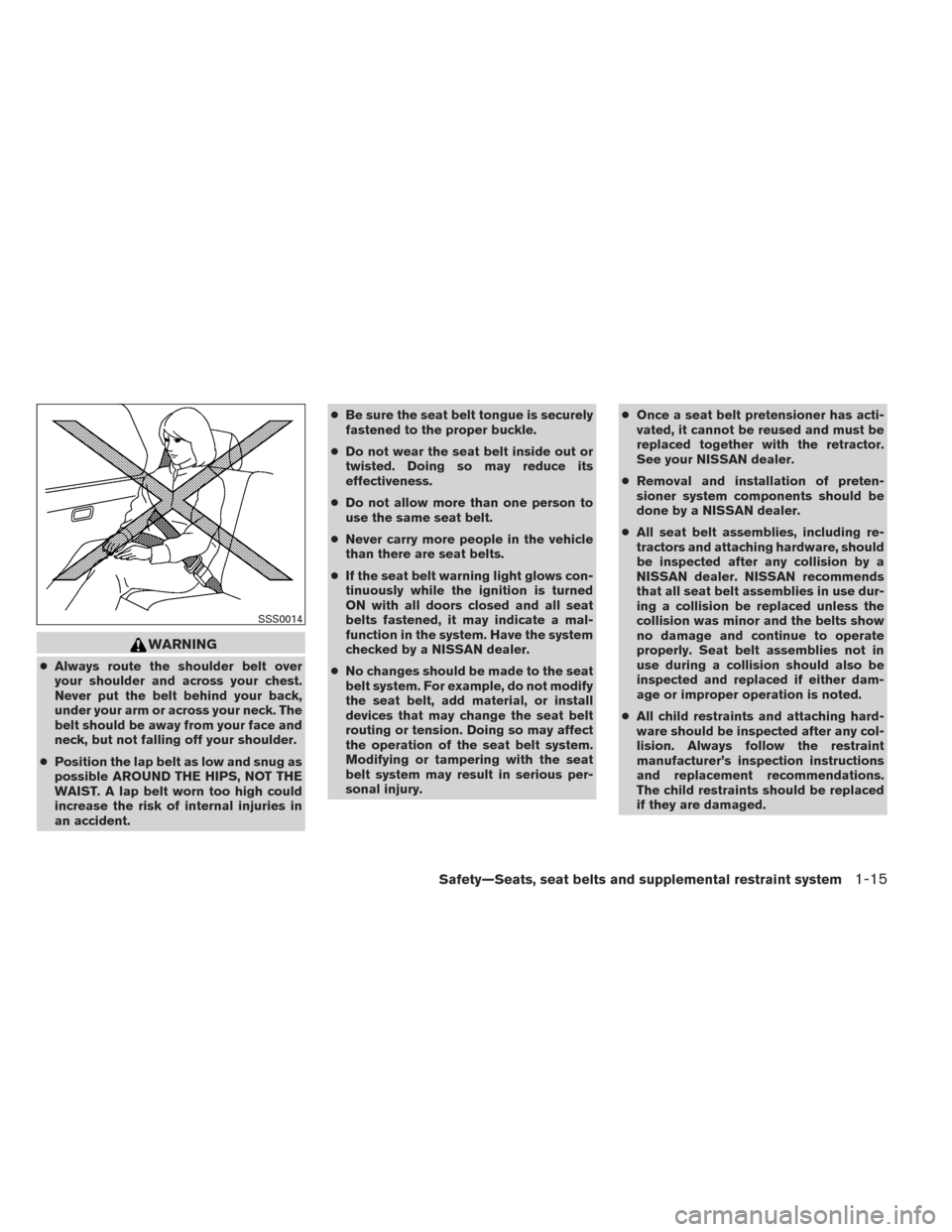
WARNING
●Always route the shoulder belt over
your shoulder and across your chest.
Never put the belt behind your back,
under your arm or across your neck. The
belt should be away from your face and
neck, but not falling off your shoulder.
● Position the lap belt as low and snug as
possible AROUND THE HIPS, NOT THE
WAIST. A lap belt worn too high could
increase the risk of internal injuries in
an accident. ●
Be sure the seat belt tongue is securely
fastened to the proper buckle.
● Do not wear the seat belt inside out or
twisted. Doing so may reduce its
effectiveness.
● Do not allow more than one person to
use the same seat belt.
● Never carry more people in the vehicle
than there are seat belts.
● If the seat belt warning light glows con-
tinuously while the ignition is turned
ON with all doors closed and all seat
belts fastened, it may indicate a mal-
function in the system. Have the system
checked by a NISSAN dealer.
● No changes should be made to the seat
belt system. For example, do not modify
the seat belt, add material, or install
devices that may change the seat belt
routing or tension. Doing so may affect
the operation of the seat belt system.
Modifying or tampering with the seat
belt system may result in serious per-
sonal injury. ●
Once a seat belt pretensioner has acti-
vated, it cannot be reused and must be
replaced together with the retractor.
See your NISSAN dealer.
● Removal and installation of preten-
sioner system components should be
done by a NISSAN dealer.
● All seat belt assemblies, including re-
tractors and attaching hardware, should
be inspected after any collision by a
NISSAN dealer. NISSAN recommends
that all seat belt assemblies in use dur-
ing a collision be replaced unless the
collision was minor and the belts show
no damage and continue to operate
properly. Seat belt assemblies not in
use during a collision should also be
inspected and replaced if either dam-
age or improper operation is noted.
● All child restraints and attaching hard-
ware should be inspected after any col-
lision. Always follow the restraint
manufacturer’s inspection instructions
and replacement recommendations.
The child restraints should be replaced
if they are damaged.
SSS0014
Safety—Seats, seat belts and supplemental restraint system1-15
Page 52 of 384
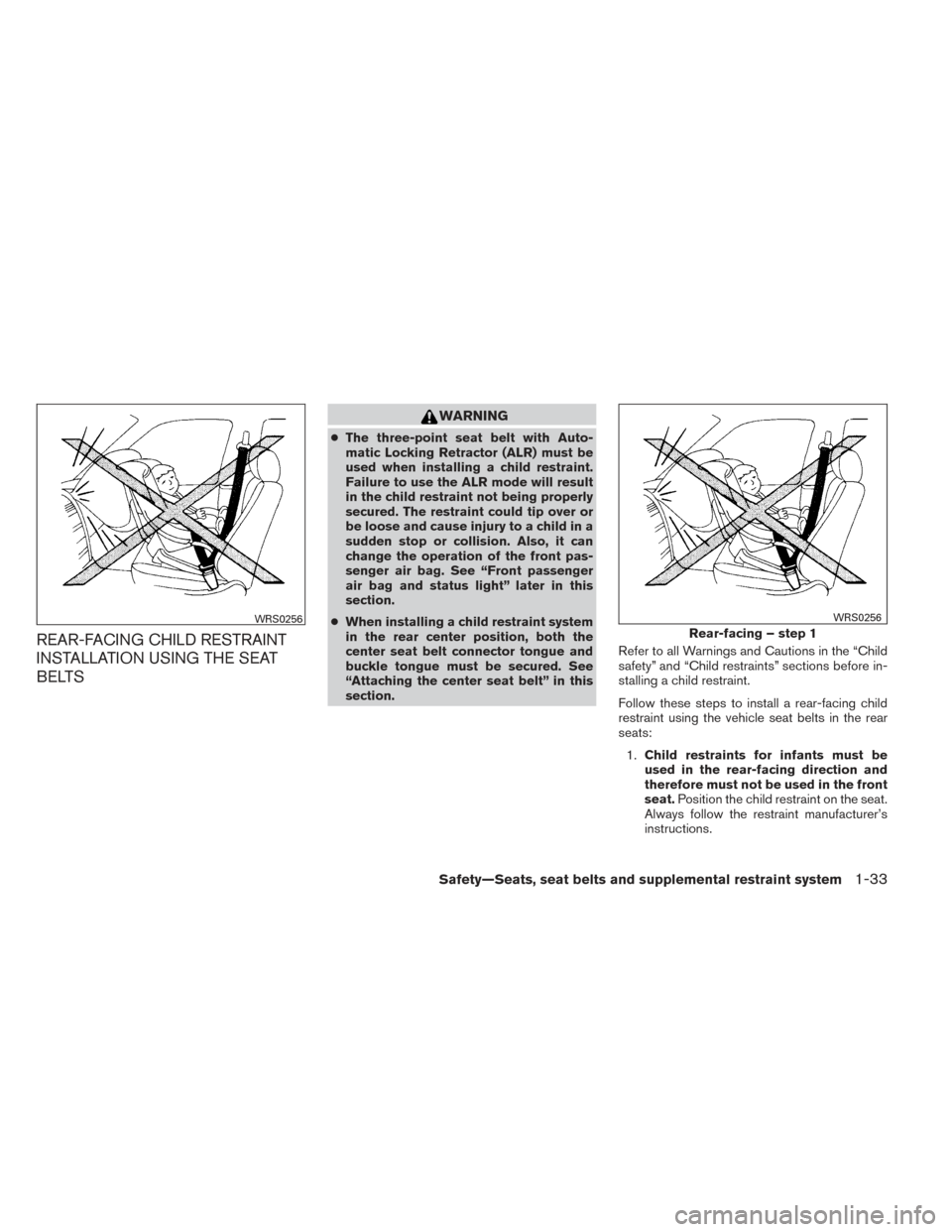
REAR-FACING CHILD RESTRAINT
INSTALLATION USING THE SEAT
BELTS
WARNING
●The three-point seat belt with Auto-
matic Locking Retractor (ALR) must be
used when installing a child restraint.
Failure to use the ALR mode will result
in the child restraint not being properly
secured. The restraint could tip over or
be loose and cause injury to a child in a
sudden stop or collision. Also, it can
change the operation of the front pas-
senger air bag. See “Front passenger
air bag and status light” later in this
section.
● When installing a child restraint system
in the rear center position, both the
center seat belt connector tongue and
buckle tongue must be secured. See
“Attaching the center seat belt” in this
section. Refer to all Warnings and Cautions in the “Child
safety” and “Child restraints” sections before in-
stalling a child restraint.
Follow these steps to install a rear-facing child
restraint using the vehicle seat belts in the rear
seats:
1. Child restraints for infants must be
used in the rear-facing direction and
therefore must not be used in the front
seat. Position the child restraint on the seat.
Always follow the restraint manufacturer’s
instructions.
WRS0256Rear-facing – step 1
WRS0256
Safety—Seats, seat belts and supplemental restraint system1-33
Page 56 of 384
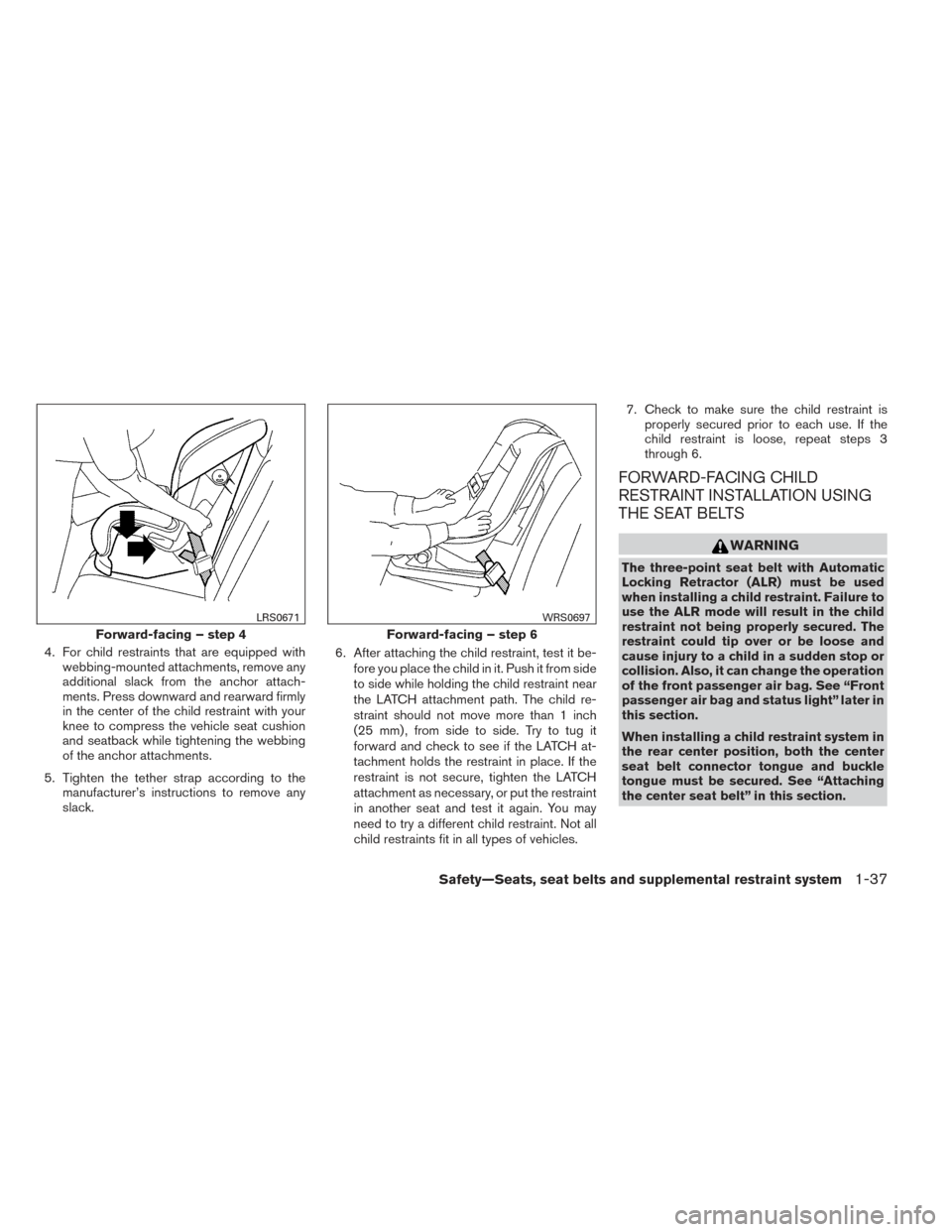
4. For child restraints that are equipped withwebbing-mounted attachments, remove any
additional slack from the anchor attach-
ments. Press downward and rearward firmly
in the center of the child restraint with your
knee to compress the vehicle seat cushion
and seatback while tightening the webbing
of the anchor attachments.
5. Tighten the tether strap according to the manufacturer’s instructions to remove any
slack. 6. After attaching the child restraint, test it be-
fore you place the child in it. Push it from side
to side while holding the child restraint near
the LATCH attachment path. The child re-
straint should not move more than 1 inch
(25 mm) , from side to side. Try to tug it
forward and check to see if the LATCH at-
tachment holds the restraint in place. If the
restraint is not secure, tighten the LATCH
attachment as necessary, or put the restraint
in another seat and test it again. You may
need to try a different child restraint. Not all
child restraints fit in all types of vehicles. 7. Check to make sure the child restraint is
properly secured prior to each use. If the
child restraint is loose, repeat steps 3
through 6.
FORWARD-FACING CHILD
RESTRAINT INSTALLATION USING
THE SEAT BELTS
WARNING
The three-point seat belt with Automatic
Locking Retractor (ALR) must be used
when installing a child restraint. Failure to
use the ALR mode will result in the child
restraint not being properly secured. The
restraint could tip over or be loose and
cause injury to a child in a sudden stop or
collision. Also, it can change the operation
of the front passenger air bag. See “Front
passenger air bag and status light” later in
this section.
When installing a child restraint system in
the rear center position, both the center
seat belt connector tongue and buckle
tongue must be secured. See “Attaching
the center seat belt” in this section.
Forward-facing – step 4
LRS0671
Forward-facing – step 6
WRS0697
Safety—Seats, seat belts and supplemental restraint system1-37
Page 63 of 384
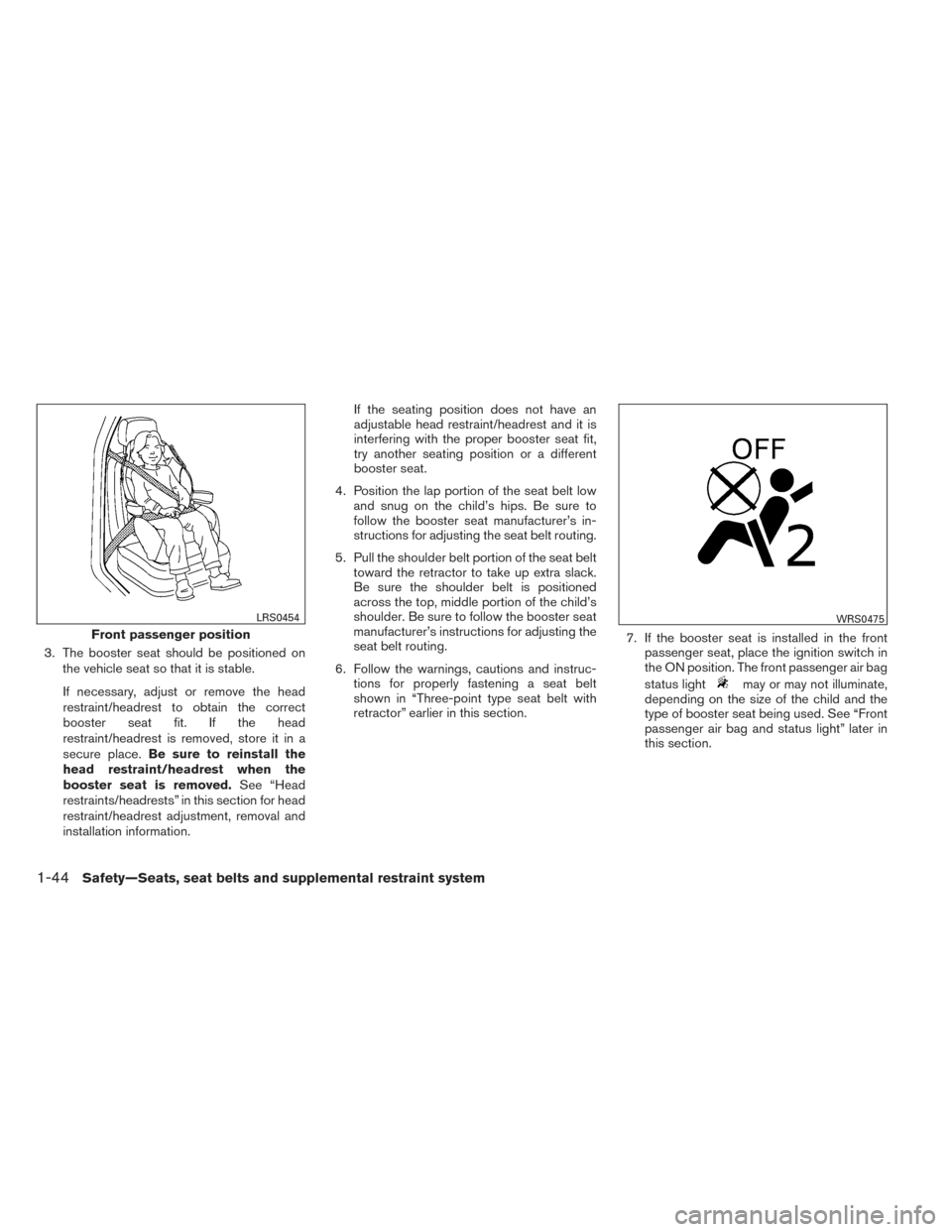
3. The booster seat should be positioned onthe vehicle seat so that it is stable.
If necessary, adjust or remove the head
restraint/headrest to obtain the correct
booster seat fit. If the head
restraint/headrest is removed, store it in a
secure place. Be sure to reinstall the
head restraint/headrest when the
booster seat is removed. See “Head
restraints/headrests” in this section for head
restraint/headrest adjustment, removal and
installation information. If the seating position does not have an
adjustable head restraint/headrest and it is
interfering with the proper booster seat fit,
try another seating position or a different
booster seat.
4. Position the lap portion of the seat belt low and snug on the child’s hips. Be sure to
follow the booster seat manufacturer’s in-
structions for adjusting the seat belt routing.
5. Pull the shoulder belt portion of the seat belt toward the retractor to take up extra slack.
Be sure the shoulder belt is positioned
across the top, middle portion of the child’s
shoulder. Be sure to follow the booster seat
manufacturer’s instructions for adjusting the
seat belt routing.
6. Follow the warnings, cautions and instruc- tions for properly fastening a seat belt
shown in “Three-point type seat belt with
retractor” earlier in this section. 7. If the booster seat is installed in the front
passenger seat, place the ignition switch in
the ON position. The front passenger air bag
status light
may or may not illuminate,
depending on the size of the child and the
type of booster seat being used. See “Front
passenger air bag and status light” later in
this section.
Front passenger position
LRS0454WRS0475
1-44Safety—Seats, seat belts and supplemental restraint system